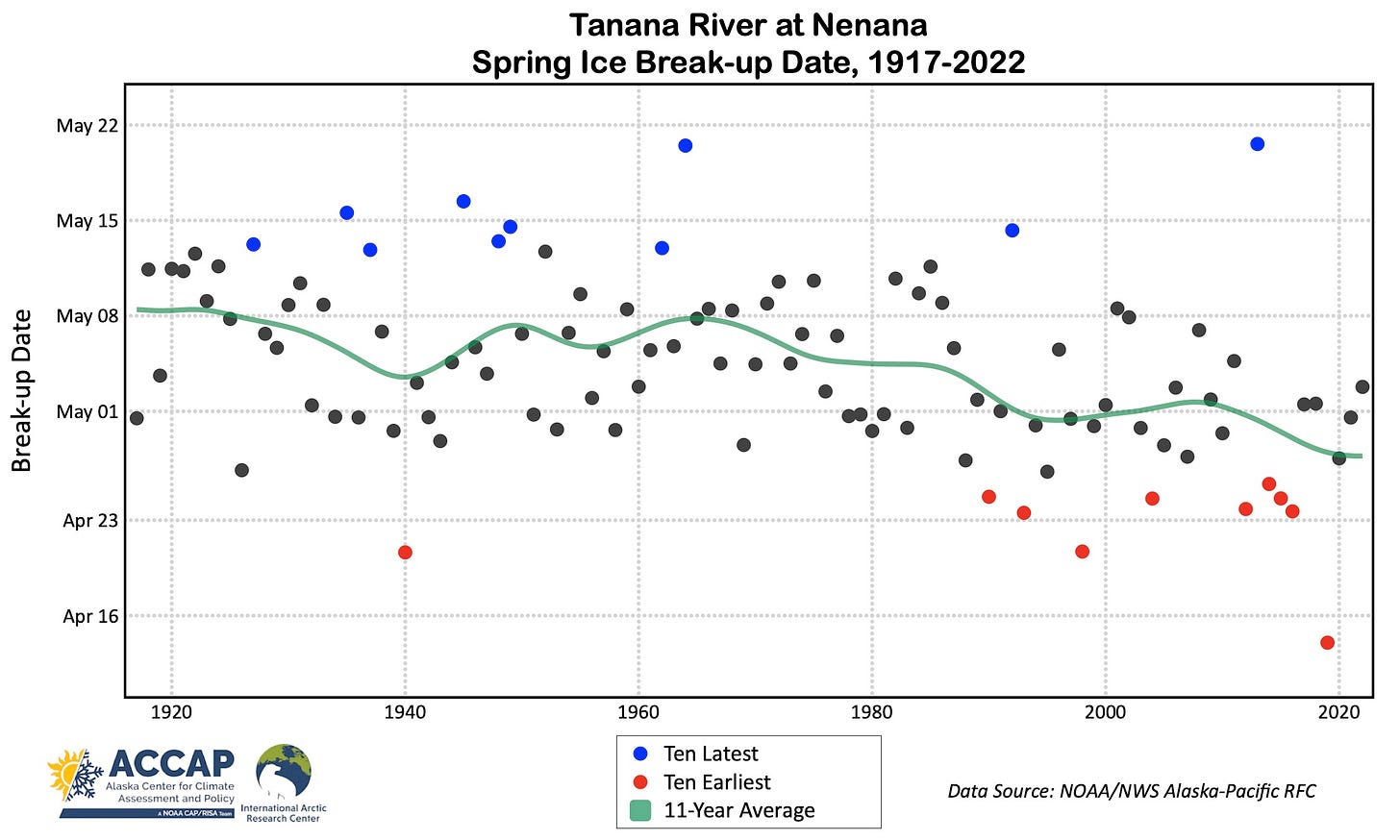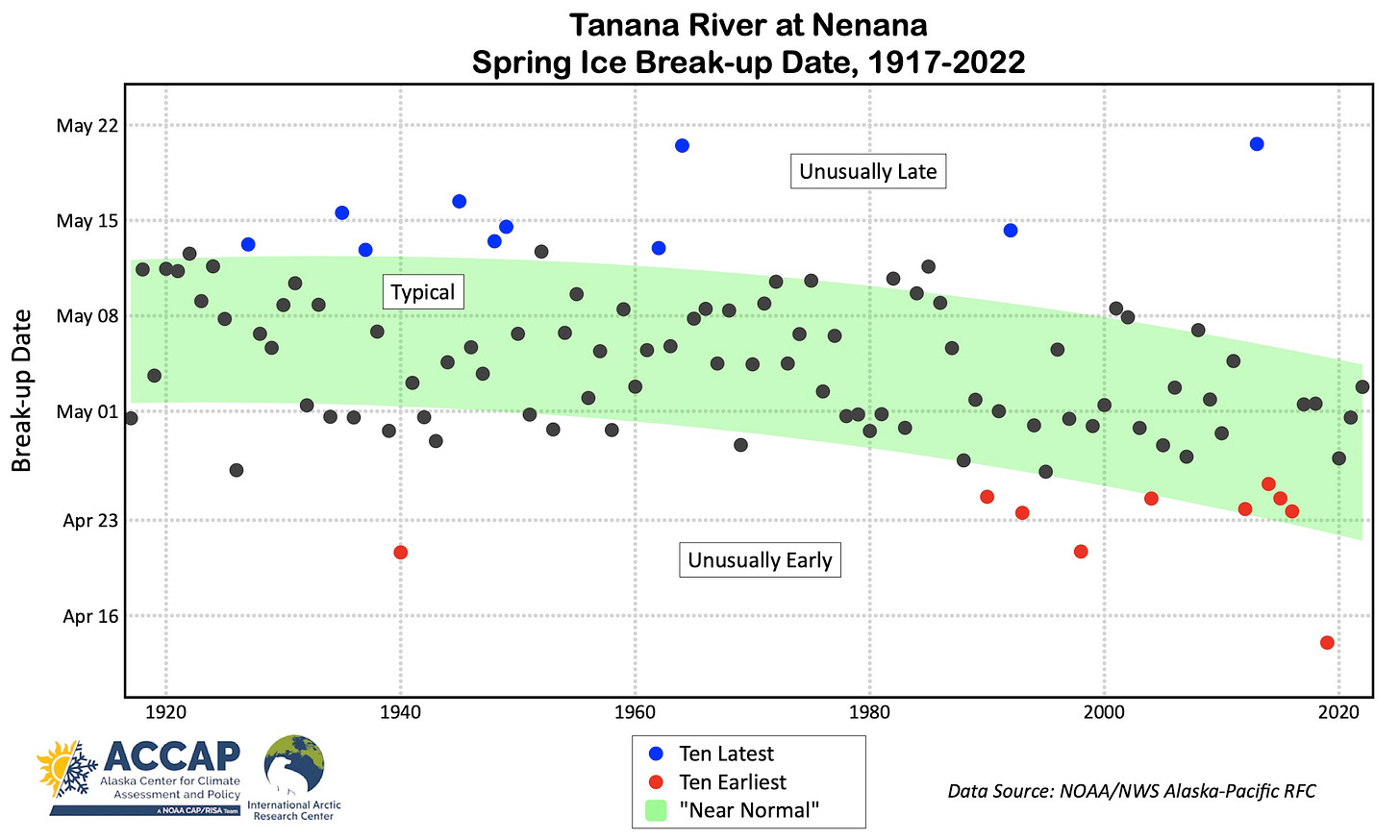Betting on the timing of river ice break-up in the North was a popular pastime by Euro-Americans in Gold Rush times and that enthusiasm continues today. At Nenana, in 1917, a group of engineers surveying for the Alaska Railroad started the tradition of placing bets on the when the ice would go out on the Tanana River. That has continued every year since then, and 106 six years later, in 2022, a pot of nearly a quarter million dollars was split between 18 tickets that correctly guessed the correct day, hour and minute (in Alaska Standard Time) the ice would go out, moving the famous “tripod” and stopping the clock.
Tanana River Break-up as a Climate Record
Inadvertently the ice break-up observations at Nenana have become one of the very best climate data sets we have in Alaska. The Tanana River is free flowing (no dams) it’s entire length and as the river passes by Nenana all the water flows in a single channel. The total number of people living in Nenana now (~500) is not much different than it was 100 years ago and there is no human development to effect the river flow upstream for many miles. Even in the Fairbanks area the development consists of dikes that serve to keep water at high levels in the multiple channels of Tanana River rather than being detoured into the slough system and flooding portions of Fairbanks before returning to the Tanana River proper. Additionally, the time of break-up has been measured in the same idiosyncratic way for nearly the entire 106 year period of record, with a large “tripod”1 set on the river ice and connected by ropes to a clock, and only when the “tripod” moves some distance downriver does the clock stop. There is no other set of river break-up observations that are this homogeneous over this long a period of time anywhere in Alaska or the Yukon, hence the unique and invaluable nature of this data.
In Fig. 1 I’ve annotated a web image of the Nenana area to situate the “tripod” location with the surrounding features and a Nenana Ice Classic webcam image from May 5, 2023.

The Data and What it Shows
Figure 2 plots the date and time of break-up each year 1917 to 2022, highlighting the ten earliest and latest break-ups along with an 11-year centered moving average. The trend is clear: into the 1960s the typical break-up was around May 8 (though averaging a few days earlier in the years around 1940). But since the 1960s there’s been a persistent albeit unsteady trend toward earlier break-ups. The clustering of the latest break-ups prior to 1965 and very early break-ups since the 1990s is clear, and overall the typical break-up nowadays is about 8 days earlier than it was through the mid 20th century.

Now a week or a bit more may not sound like a big change, but in fact the timing of break-up is fairly tightly constrained: taking into account the trend, the standard deviation of break-up dates is only around six days and that is pretty much unchanged over the past century. So the total change in typical break-up dates exceeds the level of historically typical variability. This is an excellent indication the change is more than random variation. Figure 3 shows the same break-up dates as Fig. 2 but here I’ve added an indication of the changing meaning of “late vs. early” break-ups. Prior to about 1960 a break-up any point in April was quite unusual. Nowadays break-up is often April. Similarly, in the past 20 years, any break-up after the first week of May is quite late, but through most of the 20th century a break-up the second week of May was not especially notable.

Why is Break-up Happening Earlier?
River break-up on (sub)Arctic rivers is very strongly controlled by spring temperatures. Everything else is secondary: the snowpack relative to normal at the start of the melt season is probably the next most important factor, while things like river ice thickness and the amount of sunshine during the melt season are generally only of minor significance. Ice on Tanana River at Nenana (and all other rivers in northern Alaska) is breaking up earlier in the spring simply because March and April temperatures are increasing and there a greater accumulation of warmth earlier in the season that there used to be.
Postscript: Dealing with Leap Years
There occasionally arise questions above how leap year effect these dates. These were especially common in 2013, when the ice when out on May 20, the same date as in 1964 and the latest of record. But 1964 was a leap year. So was 1964 actually one day later? So to forestall any confusion: the answer to this question is straightforward when you recall that our Gregorian calendar and associated “leap year” is a social convention without physical meaning, so the count of the “day of the year” is entirely arbitrary. The leap year “extra day” could be just as easily be added at the end of December. The people of Roman Empire were not idiots because by their convention the new year started on March 1. Knowing the date and time of break-up (in whatever calendar system) we can easily find the elapsed time from an event that might be environmentally relevant and independent of cultural conventions, for instance, winter solstice (when solar heating starts to increase) to the time of break-up. When we do this, we find using the date of break-up without regard to whether it’s a leap year or not yields a closer fit to a calendar-independent measure than fudging the break-up dates in our modern leap years.
Technical details: The Nenana Ice Classic reports all date/times in Alaska Standard Time. However, no adjustment has been made in the historical observations to reflect the time zone change of October 1983. For purposes here this is inconsequential. Nenana Ice Classic webcam images from: https://www.nenanaakiceclassic.com/
Figure 3 mean and standard deviation modeled using a quadratic linear regression in a General Additive Model framework with the R package gamlss.
“Tripod” is in quotes throughout because in recent times the structure actually has four legs, not three. However, it’s universally referred to as the Nenana Ice Classic “tripod”.




The Nenana “tripod” seems to have fallen over due to local melting. Does that count or does it have to move downstream?